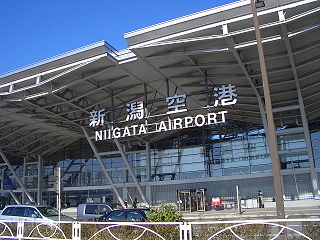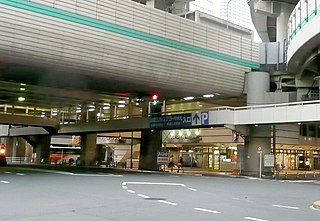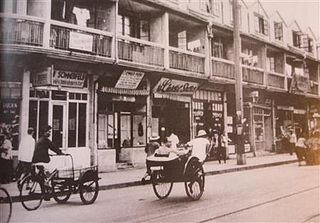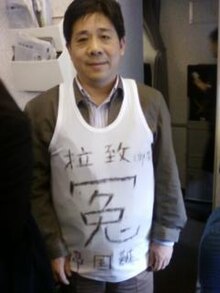
Incheon International Airport is the main international airport serving Seoul, the capital of South Korea. It is also one of the largest and busiest airports in the world.

Kansai International Airport, commonly known as 関空, is the primary international airport in the Greater Osaka Area of Japan and the closest international airport to the cities of Osaka, Kyoto, and Kobe. It is located on an artificial island in the middle of Osaka Bay off the Honshu shore, 38 km (24 mi) southwest of Ōsaka Station, located within three municipalities, including Izumisano (north), Sennan (south), and Tajiri (central), in Osaka Prefecture. The airport's 1st airport island covers approximately 510 hectares and the 2nd airport island covers approximately 545 hectares, for a total of 1,055 hectares.

Border control comprises measures taken by governments to monitor and regulate the movement of people, animals, and goods across land, air, and maritime borders. While border control is typically associated with international borders, it also encompasses controls imposed on internal borders within a single state.

Antonio B. Won Pat International Airport, also known as Guam International Airport, is an airport located in Tamuning and Barrigada, three miles (4.8 km) east of the capital city of Hagåtña in the United States territory of Guam. The airport is a hub for Asia Pacific Airlines and for United Airlines, serving as the latter's Pacific Ocean hub. It is also the home of the former Naval Air Station Agana, and is the only international airport in the territory. The airport is named after Antonio Borja Won Pat, the first delegate from Guam to the United States House of Representatives, and is operated by the A.B. Won Pat International Airport Authority, Guam, an agency of the Government of Guam.

Shanghai Hongqiao International Airport is one of two international airports of Shanghai, the largest city by population in China, and a significant airline hub of the country. Hongqiao Airport mainly serves domestic and regional flights, although the airport also serves select international flights. The airport is located near the town of Hongqiao in the outskirts of Changning and Minhang districts, 13 kilometres (8.1 mi) west of downtown, and is closer to the city center than the area's primary international airport, Shanghai–Pudong.

Narita is a city in Chiba Prefecture, Japan. As of 30 November 2020, the city had an estimated population of 131,852 in 63,098 households and a population density of 620 persons per km². The total area of the city is 213.84 square kilometres (82.56 sq mi). It is the site of Narita International Airport, one of the two main international airports serving the Greater Tokyo Area.

Naha Airport is a second class airport located 4 km (2.5 mi) west of the city hall in Naha, Okinawa. It is Japan's seventh busiest airport and the primary air terminal for passengers and cargo traveling to and from Okinawa Prefecture, Japan. It handles scheduled international traffic to Taiwan, Hong Kong, South Korea, Thailand, Singapore and mainland China. The airport is also home to Naha Air Base of the Japan Air Self-Defense Force.

The Narita Express, abbreviated as N'EX, is a limited express train service operated in Japan since 1991 by East Japan Railway Company, serving Narita International Airport from various Greater Tokyo Area stations. Services run approximately half-hourly in the mornings and evenings, and hourly through the middle of the day. The main competition for the Narita Express is Keisei Electric Railway's Skyliner.

Chubu Centrair International Airport is an international airport on an artificial island in Ise Bay, Tokoname City in Aichi Prefecture, 35 km (22 mi) south of Nagoya in central Japan. The airport covers about 470 hectares of land and has one 3,500m runway.

Niigata Airport is a second class airport located 6.7 km (4.2 mi) northeast of Niigata Station in Niigata, Japan.

Narita Airport Terminal 2·3 Station is an underground railway station located beneath Terminal 2 of Narita International Airport in Narita, Chiba, Japan. The station is linked to Higashi-Narita Station by a 500 m (1,600 ft) underground passage. The station serves both Terminal 2 and the nearby Terminal 3.

Tokyo City Air Terminal, also known as T-CAT, is a bus terminal for Airport Transport Service, an airport bus operator, in downtown Tokyo, Japan. The terminal is located in Nihonbashi-Hakozaki-cho, Chuo-ku, beneath Hakozaki Junction, the three-way interchange for Shuto Expressway's Mukojima Route and Fukagawa Route, three blocks southeast of Suitengu shrine. T-CAT is a gateway for passengers going to and from Narita International Airport and Tokyo International Airport (Haneda).

The Shanghai Ghetto, formally known as the Restricted Sector for Stateless Refugees, was an area of approximately one square mile (2.6 km2) in the Hongkou district of Japanese-occupied Shanghai. The area included the community around the Ohel Moshe Synagogue. Shanghai was notable for a long period as the only place in the world that unconditionally offered refuge for Jews escaping from the Nazis. After the Japanese occupied all of Shanghai in 1941, the Japanese army forced about 23,000 of the city's Jewish refugees to be restricted or relocated to the Shanghai Ghetto from 1941 to 1945 by the Proclamation Concerning Restriction of Residence and Business of Stateless Refugees. It was one of the poorest and most crowded areas of the city. Local Jewish families and American Jewish charities aided them with shelter, food, and clothing. The Japanese authorities increasingly stepped up restrictions, surrounded the ghetto with barbed wire, and the local Chinese residents, whose living conditions were often as bad, did not leave. By 21 August 1941, the Japanese government closed Shanghai to Jewish immigration.

Ai Weiwei is a Chinese contemporary artist, documentarian, and activist. Ai grew up in the far northwest of China, where he lived under harsh conditions due to his father's exile. As an activist, he has been openly critical of the Chinese Government's stance on democracy and human rights. He investigated government corruption and cover-ups, in particular the Sichuan schools corruption scandal following the collapse of "tofu-dreg schools" in the 2008 Sichuan earthquake. In 2011, Ai Weiwei was arrested at Beijing Capital International Airport on 3 April, for "economic crimes". He was detained for 81 days without charge. Ai Weiwei emerged as a vital instigator in Chinese cultural development, an architect of Chinese modernism, and one of the nation's most vocal political commentators.

Ibaraki Airport is an airport in the city of Omitama, Ibaraki Prefecture, Japan. It also serves as an air base for the Japan Air Self-Defense Force (JASDF) under the name Hyakuri Air Base, and is the closest fighter base to Tokyo. The airport was known as Hyakuri Airfield prior to March 2010, when civil aviation operations began.

A fake passport is a counterfeit of a passport issued by a nation or authorised agency. Such counterfeits are copies of genuine passports, or illicitly modified genuine passports made by unauthorized persons, sometimes called cobblers. Its purpose is to be used deceptively as if it were a legitimate travel or identity document. A passport obtained from an authorized issuer by providing false information may also be considered fake.

Haneda Airport, sometimes referred to as Tokyo-Haneda, is one of two international airports serving the Greater Tokyo Area, the other one being Narita International Airport (NRT). It serves as the primary base of Japan's two largest airlines, Japan Airlines and All Nippon Airways, as well as RegionalPlus Wings Corp., Skymark Airlines, and StarFlyer. It is located in Ōta, Tokyo, 15 kilometers (9.3 mi) south of Tokyo Station. The facility covers 1,522 hectares of land.

Narita International Airport, also known as Tokyo-Narita International Airport, formerly and originally known as New Tokyo International Airport, is one of two international airports serving the Greater Tokyo Area, the other one being Haneda Airport (HND). It is about 60 kilometers (37 mi) east of central Tokyo in Narita, Chiba. The facility since July 2019, covers 1,137 hectares of land and there are future plans to expand to nearly 1,200 ha.


















